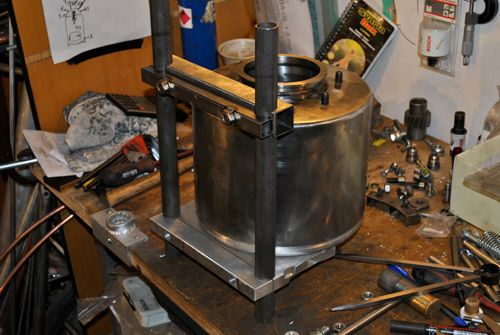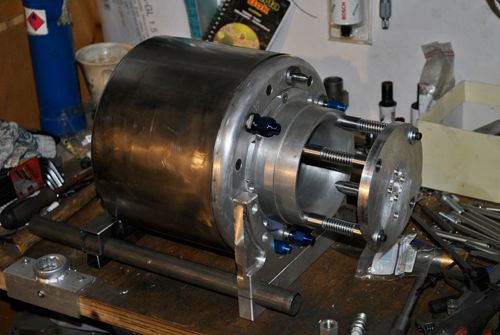|
|
Post by racket on May 19, 2011 17:40:33 GMT -5
Hi Anders
You may need to rethink the cooling fan idea , a permanently mounted fan will be subjected to engine inlet airflow rates many times its design flows which will very quickly over speed it :-(
Also any inlet restriction to the engine will reduce engine power , Andrew and I have already gone down the EDF (electric ducted fan) route with regards using one as a potential starter, ....without success , .....and also had to reconcile the other problems with having a fan in front of the compressor , ..............unless the fan can be displaced some distance from the intake during normal operation it won't last very long , and any shrapnel will go through the comp :-(
Cheers
John
|
|
|
|
Post by Johansson on May 19, 2011 23:04:49 GMT -5
Oops, it sounded like I planned to have the engine sucking air through the fan...  There will be a gap of at least 15cm between the fan and the comp inlet so the fan will only provide a gust of air blowing through the engine, the fan engine has some friction in it as well so I don´t think that the fan will be rotating from the air flow. If the fan is sucked into rotation I will make the FOD screen larger to avoid this. It is mostly for the propane preheat, it won´t be able to pull any larger amounts of heat out of the engine. For that I would need to fit a ducted fan instead which I very well might do if this turns out to work like it should. |
|
|
|
Post by racket on May 20, 2011 1:19:14 GMT -5
Hi Anders
You'll probably be running up to a 3.8 :1 PR ......2.8 bar P2 , and theres a good chance you might even risk a 3 bar run just to see what happens , I like to use a larger 63mm gauge that goes to 4 bar for a P2 gauge , the industrial gauges with finer graduations so that its possible to easily see a 1 psi change in pressure , some of the smaller boost gauges don't have enough room to fit anything other than 5 psi -0.5 bar markings .
I'll be interested to hear how the fan works :-)
Cheers
John
|
|
|
|
Post by Johansson on May 20, 2011 1:52:59 GMT -5
That high a PR? Roger that!  I´ll just save the Autometer gauge for some future turbo/supercharger bike project, always good to have "good to have" parts.  |
|
Feathers
Veteran Member
  
Joined: August 2010
Posts: 169
|
Post by Feathers on May 23, 2011 0:08:01 GMT -5
Johansson, I see that you've been looking to a brushless starter system  I am too! And will also be using a propane pre-heat. I'll suggest that instead of having an extra fan on board to preheat, just engage the starter motor at a low speed to move some air, then ramp it up to start. Also, Check out this motor. cgi.ebay.com/ws/eBayISAPI.dll?ViewItem&_trksid=p4340.l2557&rt=nc&nma=true&item=280680859135&si=2XEBd3I%252FzAhe0CB7xttovZfYEvs%253D&viewitem=&sspagename=STRK%3AMEWNX%3AITI know that its water-cooled, but with your low-friction bearings and short duty cycle, that shouldn't be a problem running dry. I'm using this motor, as 12 volts will push it over 20,000 RPM at nearly 900 watts, I'll be removing the water jacket on my lathe and mounting a heat-sink (because I need to turn over a big vt-50 turbo with sluggish hydrostatic bearings). Stay well! |
|
|
|
Post by Johansson on May 23, 2011 0:33:09 GMT -5
I am not sure if that motor will be able to spool up the VT-50, the brass bearings become really sluggish at low rotational speeds and need lots of power to get up to idle revs. That 20.000rpm rating is or an unloaded motor and will be lowered significantly when hooked up to the turbine shaft at full oil pressure. I have abandoned the electrical starter and will use 200bar compressed air to spool my turbine up, I know that John has bought some monster brushless motor for his 10/98 engine but since I had a scuba compressor I figured that it would be the easier route for me. You should still try of course, the VT-50 bearings should be a bit easier to spin than the TV94 bearings. The large axial bearing really creates some friction...  |
|
|
|
Post by Johansson on May 23, 2011 6:27:22 GMT -5
I finished the rear engine mount today and started making the FOD screen/cooling fan mount, I will reuse the parts I made for the brushless starter for this.  The fan moves a fair bit of air so I think it´ll work fine, I am even considering making a nice aluminum housing for it instead of the plastic one.   Cheers! |
|
Feathers
Veteran Member
  
Joined: August 2010
Posts: 169
|
Post by Feathers on May 23, 2011 9:10:14 GMT -5
Johansson, I've been doing some research on these brushless motors, and their strange creatures! They are somewhat like large 3-phase induction motors, in that they will suck as much current as they possibly can to remain at the RPM determined by the frequency of the signial driving the coils (the function of the speed controll). This motor will run 2,300 RPM/volt, so with my ~12.5 volt power supply, the maximum RPM (unloaded) should be ~28,750 RPM, and ~23,000 RPM when factoring in the load, and the voltage drop associated with pulling 75 amps. RC Don used 2 smaller brushless motors, for a combined output of 600 watts at 20,000 RPM, and it turns over his VT-50 with no problem. I'll be using his same pre-heat cycle to warm the oil and free up the bearings, so I think that this motor will work like a charm  . |
|
|
|
Post by Johansson on May 23, 2011 9:47:04 GMT -5
So Don spooled up his VT-50 with only 600W? Well then it might just work for you too, give it a shot!  |
|
|
|
Post by racket on May 23, 2011 18:27:43 GMT -5
Hi Feathers
Easy way to see if it might do the job , measure the rotational torque of your turbo rotor with full oil pressure and cold oil , it'll be only a few inch/pounds hopefully ..............the TV94 rotors that Anders and I are using need ~ 6 inch pounds -0.5 ft lbs to get them moving .
Now a 2300 Kv motor at 75 amps will produce 0.311 N-m or 0.22 ft lbs or 2.75 inch pounds of torque , you probably need twice the rotor torque for acceleration of the rotor once air loads start to build
Hope this helps
Cheers
John
|
|
Feathers
Veteran Member
  
Joined: August 2010
Posts: 169
|
Post by Feathers on May 23, 2011 21:39:34 GMT -5
Hi John,
Rc Don used two motors with a maximum (max = fry an egg on the heatsink) combined output of 600 watts, and ran them through a gearbox to bring the output down to 20,000 rpm at 12 volts. 20,000 RPM at 600 watts rounds out to roughly 2.5 oz-inches, and his VT-50 roars to life without a hickup, provided he pre-heated the oil.
I like to stay away from physics, the ammount of variables present in systems such as the hydrostatic bearings of the VT-50, given viscosity, which is a function of oil brand and temperature, as well as air resistance, and finding the sometimes foggy "break-even" point at which the turbine begins generating torque, and relieves the starter motors, and a gajillion more factors can sometimes make calculations and numbers misleading.
Not to say that they don't serve a purpose! And they are probably MUCH more use to guys like yourself, and Johansson who have a better understanding of the principles which apply to this engine, and of the physics itsself.
I've already ordered this motor (only $30 US!) and am gonna try it out, just for kicks.
If it fails, then I'll get another ;D
If not, then we have another starter alternative!
Looks like your pretty close to first light Johansson, bet it'll run as well as it looks!
Godspeed,
Feathers
|
|
wolfdragon
Senior Member
  
Joined: April 2011
Posts: 287
|
Post by wolfdragon on May 23, 2011 21:40:31 GMT -5
how did you convert rpm and Kv rating to torque?
|
|
Feathers
Veteran Member
  
Joined: August 2010
Posts: 169
|
Post by Feathers on May 23, 2011 23:16:28 GMT -5
Wolfdragon, Kv (or KV or kV) when refering to brushless motors means RPM per volt (not Killovolts  ). A motor designed for 500 Kv would run at 500 rpm when supplied with one volt, 6,000 RPM when supplied with 12 volts, etc. Torque can be expressed as a function of rotational power output (watts, horsepower, etc.), and RPM. This is boiled down from the equation describing the relationship between torque, and rotational speed. I use the equation Horsepower=[(lb*ft torque)*RPM]/5252 (5252 is a constant used for converting RPM to radians/second in this form) Feathers |
|
|
|
Post by racket on May 23, 2011 23:39:09 GMT -5
Hi Wolf
I was looking at an electric bike Forum and the formulii were on there .
Cheers
John
|
|
|
|
Post by racket on May 23, 2011 23:41:39 GMT -5
Hi Feathers
Beware of burning out you speed controller , I wrecked a good Mamba controller trying to start the 10/98 engine with an underpowered motor :-(
Checkout the 10/98 Thread for my starter "adventures"
Cheers
John
|
|